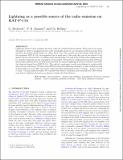Is lightning a possible source of the radio emission on HAT-P-11b?
Abstract
Lightning induced radio emission has been observed on Solar System planets. There have been many attempts to observe exoplanets in the radio wavelength, however, no unequivocal detection has been reported. Lecavelier des Etangs et al. (2013, A&A, 552, A65) carried out radio transit observations of the exoplanet HAT-P-11b, and suggested that a small part of the radio flux can be attributed to the planet. In the current letter, we assume that this signal is real, and study if this radio emission could be caused by lightning in the atmosphere of the planet. We find that a lightning storm with 530 times larger flash densities than the Earth-storms with the largest lightning activity is needed to produce the observed signal from HAT-P-11b. The optical counterpart would nevertheless be undetectable with current technology. We show that HCN produced by lightning chemistry of such thunderstorms is observable 2-3 years after the storm, which produces signatures in the L (3.0μm − 4.0μm) and N (7.5μm − 14.5μm) infrared bands. We conclude that future, combined radio and infrared observations may lead to lightning detection on planets outside the Solar system.
Citation
Hodosán , G , Rimmer , P B & Helling , C 2016 , ' Is lightning a possible source of the radio emission on HAT-P-11b? ' , Monthly Notices of the Royal Astronomical Society , vol. 461 , no. 2 , pp. 1222-1226 . https://doi.org/10.1093/mnras/stw977
Publication
Monthly Notices of the Royal Astronomical Society
Status
Peer reviewed
ISSN
0035-8711Type
Journal article
Description
We highlight financial support of the European Community under the FP7 by an ERC starting grant number 257431.Collections
Items in the St Andrews Research Repository are protected by copyright, with all rights reserved, unless otherwise indicated.

